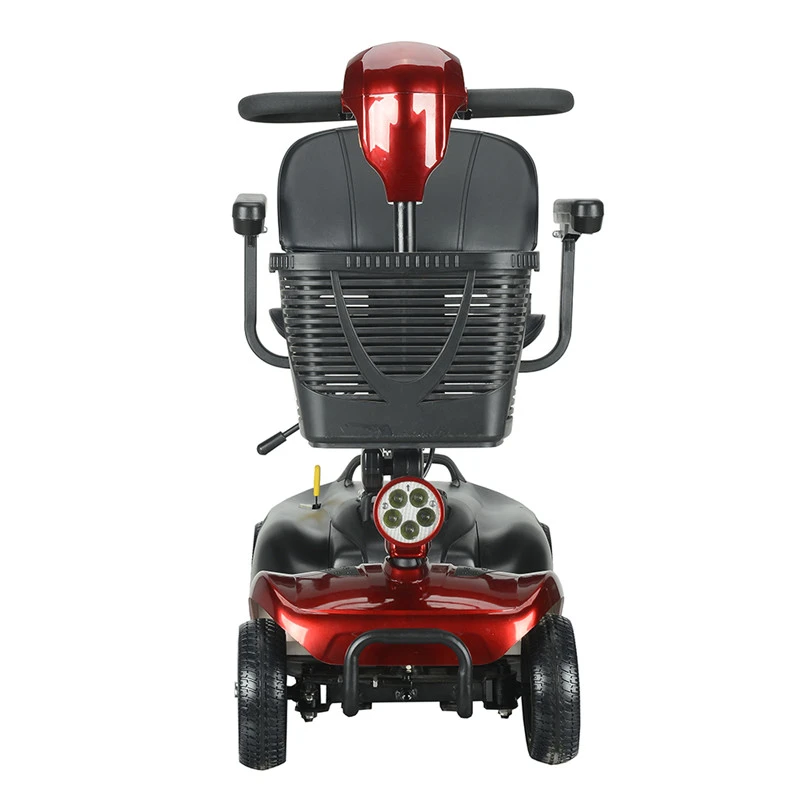wheelchair scooters have become an essential tool for individuals seeking enhanced mobility and independence. These scooters are a vital part of the mobility aids industry, providing individuals with disabilities or limited mobility the chance to navigate their environments comfortably. This article will address some of the most frequently asked questions regarding wheelchair scooters, offering insights into important considerations such as choosing the right model, understanding different types, maintenance tips, and more.
Choosing the Right Wheelchair Scooter
Purchasing a wheelchair scooter is a significant decision that can greatly impact one's quality of life. Here are some key factors to consider when selecting the right wheelchair scooter:
● Comfort Considerations
Comfort is paramount when choosing a wheelchair scooter. Individuals should prioritize scooters with comfortable seating that includes adequate padding and support. Adjustable armrests and backrests can further enhance comfort, allowing for a personalized fit. A smooth ride that absorbs shocks and vibrations will contribute to a more pleasant experience, especially during prolonged use.
● Portability and Transportability
For many users, the ability to transport their wheelchair scooter is crucial. Portable models, often lightweight and foldable, offer the flexibility to easily store or transport the scooter in a vehicle. Those who frequently travel or need to carry their scooter in various forms of transportation should consider models designed for easy disassembly and reassembly.
● Weight Capacity Requirements
Ensuring that a wheelchair scooter can safely support the user's weight is a critical consideration. Each model comes with a specified weight capacity, and it's important to select a scooter that accommodates this requirement. Exceeding the weight limit can affect the scooter's performance and safety.
● Intended Use and Environment
The intended environment for scooter use plays a significant role in selecting the right model. Whether the scooter will be used indoors, outdoors, or in both settings will determine the type of wheels, motor power, and battery capacity needed. For example, scooters meant for outdoor use may require larger wheels and more powerful motors to handle uneven terrain.
3-Wheel vs. 4-Wheel Scooters
Understanding the differences between 3-wheel and 4-wheel scooters is essential for making an informed purchase decision. Each type offers distinct advantages and is suited to different needs.
● Differences in Stability and Maneuverability
3-wheel scooters are generally more compact and offer a tighter turning radius, making them ideal for indoor use and navigating tight spaces. However, 4-wheel scooters provide greater stability, particularly on uneven surfaces, due to their wider wheelbase. Users must weigh the need for maneuverability versus stability based on their typical use scenarios.
● Size and Weight Comparison
3-wheel scooters are typically lighter and easier to transport, while 4-wheel scooters offer additional support and durability. Considering the size and weight of the scooter in relation to one’s capacity to handle it during everyday use is important.
● Turning Radius Efficiency
One of the main benefits of 3-wheel scooters is their superior turning radius, allowing users to navigate tight corners and narrow hallways with ease. This feature makes 3-wheel scooters a popular choice for indoor environments where space might be limited.
Factors Affecting Scooter Comfort
Several factors contribute to the overall comfort of a wheelchair scooter, which is crucial for users who spend significant time using the device.
● Seat Design and Padding
A well-designed seat with ample padding is essential for comfort. Ergonomically designed seats that conform to the user's body can prevent fatigue and discomfort during extended use. Some models offer memory foam or gel-infused seats for added comfort.
● Adjustable Armrests and Legroom
Adjustable features such as armrests and legroom allow for a more personalized fit. Users can modify these components to their preferred height and width, providing better support and reducing strain.
● Suspension and Shock Absorption
A scooter with effective suspension and shock absorption can greatly improve ride comfort, particularly on rough terrain. This feature minimizes vibrations and impacts, ensuring a smoother and more pleasant ride.
Portability and Storage Options
For those who need to transport their wheelchair scooter, portability is a key factor. Different models offer varying levels of portability and storage convenience.
● Foldable Versus Non-Foldable Models
Foldable scooters are designed for easy storage and transportation, often featuring lightweight frames and quick-folding mechanisms. Non-foldable models may offer other benefits, such as increased durability and weight capacity, but can be more challenging to transport.
● Lightweight Materials and Construction
Scooters made from lightweight yet durable materials such as aluminum or composite materials balance portability with strength. Choosing a scooter constructed from these materials can make a significant difference in ease of handling.
● Ease of Disassembly and Reassembly
Some scooters are designed to be easily disassembled into smaller, manageable pieces for transport. This feature is particularly useful for users who need to fit the scooter into a car trunk or other compact spaces.
Understanding Weight Capacity
The weight capacity of a wheelchair scooter is a crucial specification that can affect safety and performance. Here's what potential buyers need to know:
● Importance of Weight Limits
Manufacturers specify weight limits for each model to ensure safe and optimal performance. Adhering to these limits is essential to avoid potential damage to the scooter and to maintain warranties.
● Heavier Duty Models for Higher Capacity
For users requiring higher weight capacities, heavier-duty scooters are available. These models often feature reinforced frames and larger motors to accommodate the additional weight, providing peace of mind for heavier users.
● Performance Impact of Exceeding Limits
Exceeding a scooter's weight capacity can lead to reduced battery life, slower speeds, and increased wear and tear on the scooter’s components. This can compromise safety and lead to increased maintenance costs.
Indoor and Outdoor Use Considerations
Selecting a wheelchair scooter tailored to its primary use environment can influence its effectiveness and longevity.
● Terrain Adaptability and Wheel Design
Outdoor scooters typically require larger wheels with treads for better grip and stability on varying terrains. Indoor scooters, on the other hand, benefit from smaller, smoother wheels for easier maneuverability on flat surfaces.
● Motor Power and Battery Life
The required motor power and battery capacity depend on the intended use—scooters primarily used outdoors may need more powerful motors and longer-lasting batteries to navigate larger distances and inclines.
● Compactness for Indoor Navigation
Scooters intended for indoor use should be compact, with a tight turning radius to enable easy navigation through doorways and narrow spaces. Features such as swivel seats can also aid in maneuverability indoors.
Battery and Charging Insights
A reliable battery is vital for maintaining mobility and independence with a wheelchair scooter. Here’s what users should know about scooter batteries:
● Battery Types and Capacities
Wheelchair scooters may come with different types of batteries, such as sealed lead-acid or lithium-ion. Each type offers different capacities and lifespans, influencing the overall performance and range of the scooter.
● Charging Times and Durations
Understanding the charging requirements of the scooter's battery, including expected charging times and how long a full charge will last, is essential. This information can help users plan their usage and avoid inconvenient downtime.
● Tips for Extending Battery Life
Practices such as regular charging, avoiding extreme temperatures, and storing batteries properly can extend the life of a scooter's battery. Following the manufacturer's guidelines will ensure optimal performance and longevity.
Safety Features and Accessories
Safety is a critical aspect of wheelchair scooter design, and numerous features and accessories are available to enhance user protection.
● Essential Safety Components
Standard safety features to consider include anti-tip wheels, speed limiters, and reliable braking systems. These components collectively ensure the user's safety and prevent accidents.
● Optional Accessories for Enhanced Safety
Additional accessories such as seatbelts, rearview mirrors, and custom lighting can further enhance safety. These optional features can be particularly beneficial for users who frequently navigate busy or poorly lit areas.
● Visibility Aids and Lighting Systems
Visibility is crucial for safety, especially during nighttime use. Many scooters come equipped with built-in LED lights or reflective materials to improve visibility. Adding aftermarket lighting accessories can also enhance safety further.
Maintenance and Care Tips
Proper maintenance of a wheelchair scooter ensures its longevity and optimal performance. Here are some tips for maintaining your scooter:
● Routine Checks and Cleaning
Regularly checking the scooter for loose parts, tire pressure, and battery connections and performing basic cleaning can prevent minor issues from becoming major problems. Keeping the scooter clean also helps maintain its appearance and function.
● Troubleshooting Common Issues
Familiarizing oneself with common issues such as unusual noises, reduced battery life, or steering problems can enable users to address these minor concerns promptly. Many issues can be resolved with simple adjustments or replacements.
● Professional Servicing and Parts Replacement
For more complex issues or regular servicing, consulting with a professional technician is recommended. Routine professional maintenance and timely replacement of worn-out parts can extend the life of the scooter and ensure safe operation.
Cost and Budget Considerations
When purchasing a wheelchair scooter, understanding the cost implications is crucial for making an informed decision.
● Price Range for Different Models
Wheelchair scooters vary widely in price, influenced by factors such as features, brand reputation, and material quality. Prospective buyers should research different models to find one that fits their budget without compromising on essential features.
● Long-Term Cost Implications
In addition to the initial purchase price, users should consider long-term costs such as maintenance, replacement parts, and battery replacements. Cost efficiency in the long run is an important factor in determining the true value of a scooter.
At the forefront of wheelchair scooter innovation and quality is Suqian Excellent Science And Technology Co., Ltd. Located in Shuyang National Economic and Technological Development Zone, Suqian City, Jiangsu Province, EXCELLENT stands as a renowned manufacturer of rehabilitation therapy supplies. The name EXCELLENT reflects the company’s dedication to superior product quality and customer satisfaction. As a leading wheelchair scooter manufacturer and wholesale wheelchair scooter supplier, EXCELLENT is committed to providing top-of-the-line products like mobility scooters, patients lifts, and more. The brand’s core value, "quality first, reputation first," ensures that every product meets stringent standards, earning EXCELLENT its esteemed reputation worldwide.

Post time: 2025-03-29 20:19:04

.png)





































